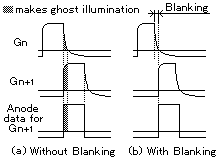Timing Characteristics for Correct Operation
Grid Scanning Frequency (Refresh Frequency)
When multiplexing, the selection of a slow grid scanning frequency may cause a flickering effect, which is a result of the optical beat generated by the on and off luminescent cycle and the image retention of the human eyes. As the anode and grid current is varied by the filament voltage level, you may observe flickering when the beat frequency between the AC filament (or pulse) and the grid scanning is 40Hz or less. Therefore we would suggest combinations as per Table 1.
| Filament Frequency | Grid Scanning Frequency |
|---|---|
| 50Hz | 90Hz or above |
| 60Hz | 100Hz or above |
| Frequency above 10kHz | 60Hz or above |
Alternatively, high frequency scanning may cause problems because of insufficient pulse width for luminance against blanking time. If flickering is caused by this, avoid a scanning frequency between 250Hz and 500Hz.
Inter-Digit Blanking

Fig.9 Inter-Digit Blanking
Another potential hazard in multiplexing is ghosting. This phenomena is caused by decaying grid signal pulses which are caused by stray capacitance between VFD electrodes and display drivers. If the grid timing overlaps the following grid and anode signal pulses, as shown in Fig.9(a), ghost illumination appears at un-addressed anode segments.
To overcome this problem, an inter-digit blanking time should be added between grid pulse timings as shown in Fig.9(b). Generally the inter-digit blanking time should be approximately 10 to 50usec, but this can vary depending on the delay time. Delay time occurs when high value pull down resistor type drivers are used or when the drive circuit is situated away from the VFD. We recommend that an appropriate inter-digit blanking time is utilized on the grid signal only, rather than on both grid and anode signals.
Guide to VFD Operation






